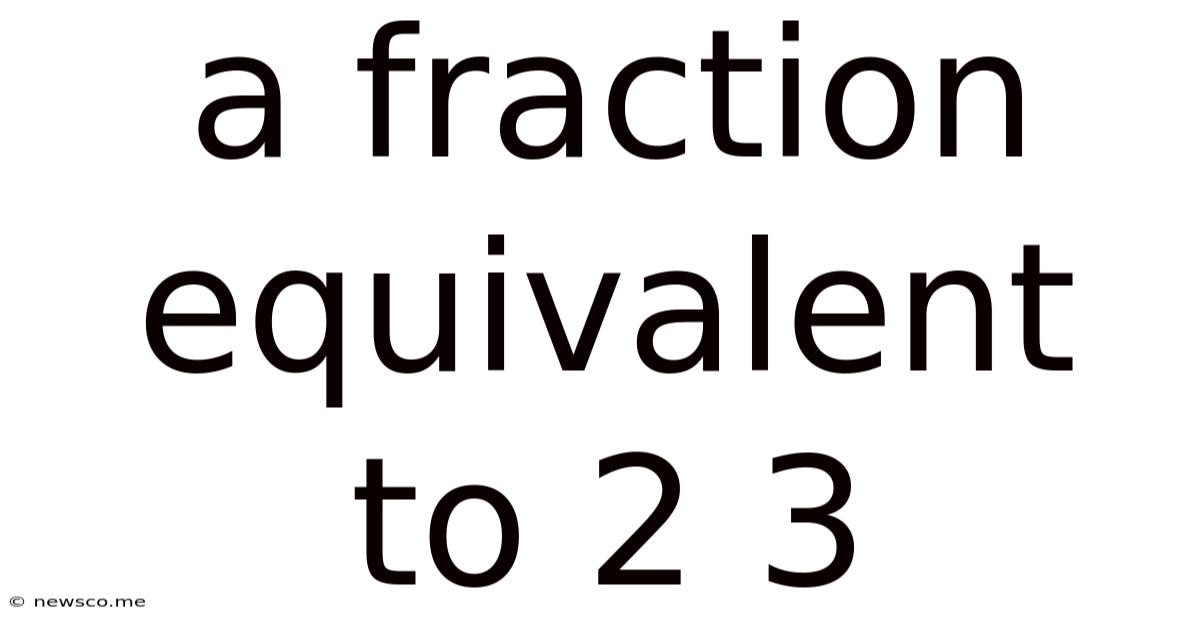A Fraction Equivalent To 2 3
News Co
May 08, 2025 · 4 min read

Table of Contents
Fractions Equivalent to 2/3: A Deep Dive into Rational Numbers
Understanding fractions is fundamental to mathematics and numerous real-world applications. This comprehensive guide delves into the concept of fractions equivalent to 2/3, exploring various methods for finding them, their significance, and practical examples. We'll cover the theoretical underpinnings and offer practical strategies to help you master this crucial mathematical concept.
What are Equivalent Fractions?
Before we dive into fractions equivalent to 2/3, let's establish a solid understanding of equivalent fractions in general. Equivalent fractions represent the same value, even though they appear different. They are essentially different ways of expressing the same portion of a whole. Think of cutting a pizza: half (1/2) is the same as two quarters (2/4), and four eighths (4/8). These are all equivalent fractions.
The key to understanding equivalent fractions lies in the concept of multiplying or dividing both the numerator (top number) and the denominator (bottom number) by the same non-zero number. This process doesn't change the value of the fraction; it simply changes its representation.
Example:
- 1/2 * 2/2 = 2/4
- 1/2 * 3/3 = 3/6
- 1/2 * 4/4 = 4/8
Finding Fractions Equivalent to 2/3
Now, let's apply this principle to find fractions equivalent to 2/3. To find an equivalent fraction, we simply multiply both the numerator (2) and the denominator (3) by the same number. Let's explore several examples:
Multiplying by 2:
- 2/3 * 2/2 = 4/6
Multiplying by 3:
- 2/3 * 3/3 = 6/9
Multiplying by 4:
- 2/3 * 4/4 = 8/12
Multiplying by 5:
- 2/3 * 5/5 = 10/15
And so on... We can continue this process indefinitely, generating an infinite number of fractions equivalent to 2/3. Each of these fractions represents the same portion of a whole as 2/3.
Simplifying Fractions: Finding the Simplest Form
While we can generate infinitely many equivalent fractions, it's often beneficial to find the simplest form of a fraction. The simplest form is when the greatest common divisor (GCD) of the numerator and denominator is 1. In other words, the only number that can divide both the numerator and denominator without leaving a remainder is 1. This is also known as simplifying or reducing a fraction.
For example, let's consider the fraction 6/9. The GCD of 6 and 9 is 3. Dividing both the numerator and denominator by 3, we get:
6/9 ÷ 3/3 = 2/3
This confirms that 6/9 is equivalent to 2/3, and 2/3 is the simplest form of the fraction.
Visualizing Equivalent Fractions
Visual representations can significantly enhance understanding. Imagine a rectangular chocolate bar. If we divide it into three equal pieces and take two, we have 2/3 of the bar. Now, imagine dividing the same chocolate bar into six equal pieces. Taking four of those pieces still represents the same amount of chocolate, 4/6, which is equivalent to 2/3. Similarly, dividing the bar into nine pieces and taking six represents 6/9, which is again equivalent to 2/3. This visual demonstration highlights the concept of equivalent fractions.
Applications of Equivalent Fractions in Real-Life
Equivalent fractions are not just abstract mathematical concepts; they have practical applications in various real-world scenarios:
-
Baking: A recipe calls for 2/3 cup of sugar. You can easily substitute with 4/6 cup or 6/9 cup without altering the recipe's outcome.
-
Construction: Measuring precise lengths and materials often involves fractions. Understanding equivalent fractions is crucial for accurate measurements and construction.
-
Finance: Calculating percentages, discounts, and interest involves working with fractions. The ability to simplify and find equivalent fractions helps in accurate financial calculations.
-
Data Analysis: When dealing with percentages and proportions in data analysis, understanding equivalent fractions is essential for accurate interpretation and representation of data.
Identifying Equivalent Fractions: A Step-by-Step Guide
Here's a step-by-step guide to determine if two fractions are equivalent:
-
Find the simplest form: Simplify both fractions to their simplest form by dividing both the numerator and denominator by their greatest common divisor (GCD).
-
Compare the simplified fractions: If the simplified fractions are identical, then the original fractions are equivalent.
Advanced Concepts: Ratios and Proportions
The concept of equivalent fractions is closely related to ratios and proportions. A ratio is a comparison of two quantities, often expressed as a fraction. A proportion states that two ratios are equal. Understanding equivalent fractions is vital for solving problems involving ratios and proportions.
Conclusion: Mastering Equivalent Fractions
Understanding equivalent fractions is a cornerstone of mathematical proficiency. It's a concept that extends beyond the classroom, finding practical applications in diverse fields. By mastering the techniques for finding equivalent fractions, simplifying fractions, and visualizing their representations, you'll significantly enhance your mathematical abilities and problem-solving skills. The ability to work confidently with fractions will undoubtedly prove valuable in your academic pursuits and various aspects of everyday life. Remember, practice is key. The more you work with equivalent fractions, the more intuitive and effortless the process will become. This thorough understanding will empower you to tackle more complex mathematical problems with increased confidence and accuracy.
Latest Posts
Latest Posts
-
What Is 12 To The Power Of 2
May 08, 2025
-
5 Times 10 To The Power Of 4
May 08, 2025
-
What Is The Absolute Value Of 14
May 08, 2025
-
What Is 1 3 4 Divided By 2 As A Fraction
May 08, 2025
-
How Do You Write 3 As A Decimal
May 08, 2025
Related Post
Thank you for visiting our website which covers about A Fraction Equivalent To 2 3 . We hope the information provided has been useful to you. Feel free to contact us if you have any questions or need further assistance. See you next time and don't miss to bookmark.